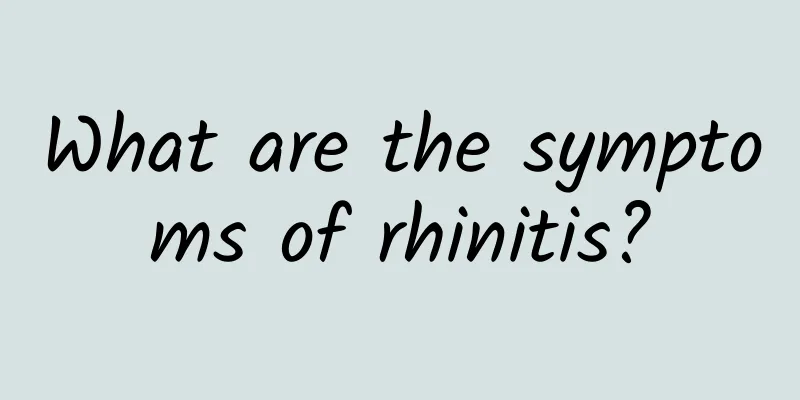Symptoms of cerebral infarction

|
Cerebral infarction is a disease with a high incidence rate nowadays, especially among the elderly. However, this disease is now increasingly developing towards young people, especially middle-aged people. Everyone should pay attention to it. When cerebral infarction occurs, there are usually some signs. Many times the symptoms are not very obvious, so they are easily ignored. Everyone should understand the symptoms of cerebral infarction. Everyone should be familiar with cerebral infarction. Once this disease occurs, it will have a great impact on the patient and the entire family. If you do not understand the symptoms of cerebral infarction and fail to discover the disease when it occurs, the condition will become more and more serious and even life-threatening. There will be some signs of cerebral infarction in the early stages, which will appear suddenly in front of the eyes and recover after a few seconds, without being accompanied by nausea, vomiting, impaired consciousness and limb paralysis. This is caused by reduced blood flow to the brain or by tiny blood clots passing through the retinal arteries. Because the ophthalmic artery is the first branch of the carotid artery and is most sensitive to carotid artery sclerosis, stenosis, and ischemia, amaurosis can be regarded as the earliest warning sign of cerebral infarction. 1. Symptoms People who are more likely to suffer from cerebral infarction are people over 50 to 60 years old, often those with atherosclerosis, hypertension, rheumatic heart disease, coronary heart disease or diabetes, as well as those with bad habits such as smoking and drinking. About 25% of patients have a history of transient ischemic attack before the onset of the disease. There are often prodromal symptoms before the onset of the disease, such as headache, dizziness, vertigo, transient limb numbness and weakness. The onset is generally slow, and patients often develop the disease when they are quiet or sleeping. For most patients, symptoms reach their peak after a few hours or even 1 to 3 days. After a cerebral infarction, most patients are conscious, while a few may have varying degrees of consciousness disorders. Generally, there are no obvious changes in vital signs. If a large area of cerebral hemisphere is infarcted, ischemic, or edematous, the function of the diencephalon and brainstem may be affected, resulting in impaired consciousness and even brain herniation and death soon after the onset of the disease. If the patient becomes unconscious immediately after the onset of the disease, vertebral-basilar artery system cerebral infarction should be considered. 1. Main clinical symptoms The clinical symptoms of cerebral infarction are complex, which are related to the site of brain damage, the size of ischemic blood vessels, the severity of ischemia, the presence or absence of other diseases before the onset of the disease, and the presence or absence of other important organ diseases. In mild cases, there may be no symptoms at all, that is, asymptomatic cerebral infarction; it may also manifest as recurrent limb paralysis or dizziness, that is, transient ischemic attack; severe cases may not only have limb paralysis but also coma and death. If the lesion affects the cerebral cortex, epileptic seizures may occur in the acute phase of cerebrovascular disease, with the highest incidence rate within 1 day after the onset of the disease. Cerebrovascular disease with epilepsy as the first onset is rare. Common symptoms include: (1) Subjective symptoms: headache, dizziness, vertigo, nausea and vomiting, motor and/or sensory aphasia, and even coma. (2) Cranial nerve symptoms: both eyes staring toward the side of the lesion, central facial paralysis and tongue paralysis, pseudobulbar palsy such as choking on water and difficulty swallowing. (3) Physical symptoms: hemiplegia or mild hemiplegia, hemisesthesia, unstable gait, limb weakness, incontinence, etc. 2. Clinical classification of cerebral infarction site: Lacunar infarction has the largest infarction area, and its clinical manifestations are: subacute onset, dizziness, unsteady gait, limb weakness, a few have choking when drinking water, difficulty swallowing, hemiplegia, hemisensory impairment, and some patients have no localizing signs. Medium-sized infarction is more common in the basal ganglia, paralateral ventricle, thalamus, bilateral frontal lobe, and temporal lobe areas. The clinical manifestations are: sudden headache, dizziness, frequent nausea and vomiting, clear consciousness, hemiplegia, or hemisensory disturbance, hemianopsia, central facial paralysis and tongue paralysis, pseudobulbar palsy, aphasia, etc. Patients with large-area infarction have an acute onset and severe clinical manifestations, and may suffer from hemiplegia, hemisesthesia, or even quadriplegia, cerebral hernia, and coma. (1) Internal carotid artery occlusion: Internal carotid artery occlusion may be asymptomatic. Symptomatic occlusion can cause manifestations similar to those of middle cerebral artery occlusion, such as hemiparesis on the side contralateral to the lesion, hemiesthesia, homonymous hemianopsia, and aphasia if the dominant hemisphere is involved. Intracranial or extracranial internal carotid artery occlusion accounts for 1/5 of ischemic cerebrovascular disease. In cases of internal carotid artery atherosclerotic occlusion, nearly 15% of cases have precursors, including TIA and monocular blindness caused by ipsilateral retinal artery ischemia. Due to the effect of the skull base artery ring, the symptoms of internal carotid artery occlusion are complicated. Sometimes internal carotid artery occlusion may not cause focal symptoms, which depends on the compensatory function of collateral circulation such as the anterior and posterior communicating arteries, ophthalmic artery, and superficial cerebral arteries. It may also be accompanied by transient blindness and Horner's syndrome. (2) Middle cerebral artery occlusion: Since the middle cerebral artery supply area is the most commonly affected area by ischemic cerebrovascular disease, the clinical signs that occur depend on the affected area. ① Occlusion of the main trunk of the middle cerebral artery: occurs at the proximal end of the lenticulostriate artery that gives off the middle cerebral artery. Because the entire area supplied by the middle cerebral artery is affected, this is the most serious type of cerebrovascular disease caused by occlusion of this artery. The clinical manifestations of main trunk occlusion are hemiplegia, hemisensory disturbance and hemianopsia on the side opposite to the lesion. Occlusion of the main trunk of the dominant hemisphere artery may cause aphasia, agraphia and alexia. If the infarction area is large, severe cases may cause increased intracranial pressure, coma, brain herniation, and even death. ② Occlusion of the deep branches of the middle cerebral artery or the lenticulostriate artery: It can cause hemiplegia on the side opposite the lesion, generally without sensory impairment or homonymous hemianopsia. The dominant hemisphere is damaged and may cause aphasia. ③ Occlusion of the cortical branches of the middle cerebral artery: It can cause hemiplegia on the side contralateral to the lesion, mainly on the face and upper limbs. The dominant hemisphere can cause motor aphasia, sensory aphasia, alexia, agraphia, and apraxia, while the non-dominant hemisphere can cause body image disorders such as contralateral hemi-neglect. We should all pay attention to the symptoms of cerebral infarction. Nowadays, there are a lot of such cardiovascular and cerebrovascular diseases. No matter where you go, you can see many patients with cerebral infarction. Generally, mild cases will not have any impact. If treated in time, the disease can be controlled. If not treated in time, paralysis will occur, which will affect one's life. |
>>: Symptoms of retinal detachment
Recommend
What does Ganoderma lucidum spore powder taste like?
As for Ganoderma lucidum spore powder, I believe ...
Where to massage for blocked bladder meridian
The bladder meridian is mainly distributed on the...
Can I eat Tremella if I have stomach problems?
Stomach disease is quite common in life, and ther...
What are the functions and effects of bitter melon soaked in wine? What is the brewing method?
Bitter melon wine is a kind of health-care medici...
What causes spinal pain during cesarean section anesthesia?
After a cesarean section, spinal pain is also a c...
How to reduce belly fat by cesarean section
During pregnancy, because the diet is relatively ...
Can a fetus be deafened in the womb?
Generally speaking, pregnant mothers who are preg...
Can I eat the red radish after it sprouts?
Can red summer mulberry be eaten after it sprouts...
What causes burning in the urethra?
Burning in the urethra is a very common condition...
What kind of food is more effective in replenishing kidney deficiency?
Many people will experience symptoms of low back ...
What is the reason for baby spitting up milk?
The milk that many children spit out is mostly li...
Why does my husband grind his teeth when he sleeps at night?
Some people grind their teeth until they fall asl...
What is folliculitis
Folliculitis is mainly characterized by acute or ...
No matter what age you are, practicing this exercise will have amazing results
Anyone can practice double-cross-legged sitting, ...
Is it better to soak your feet and sweat slightly?
As people continue to pay more attention to healt...









